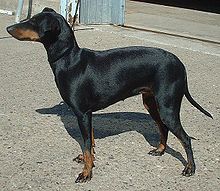Manchester Terrier

Manchester Terrier in show pose
|
||||||||||||||
| Origin | England | |||||||||||||
|---|---|---|---|---|---|---|---|---|---|---|---|---|---|---|
|
||||||||||||||
| Domestic dog (Canis lupus familiaris) | ||||||||||||||
| Classification / standards | |||
|---|---|---|---|
| FCI | Group 3, Section 1 Large/medium-sized Terriers #71 | standard | |
| AKC | Terrier (standard) and Toy (miniature) |
standard | |
| KC (UK) | Terrier | standard | |
The Manchester Terrier is a breed of dog of the smooth-haired terrier type.
The early 19th century saw times of poor sanitation in England. Rats soon became a health menace and rat killing became a popular sport. John Hulme, enthusiastic devotee of the sport of rat-baiting and rabbit coursing, crossed a whippet to a cross-bred terrier to produce a tenacious, streamlined animal better suited to the sport. This cross proved so successful that it was repeated, resulting in the establishment of a definite type.
By 1827 the breed's fighting spirit had made it equally handy along a hedge row as in a rat-pit. The Manchester could tackle an opponent twice its size. Ears were cropped to save risk of being torn in frequent scraps. (This also enhanced the sharp appearance of the expression). When rat-killing became illegal in England, rat-pits were supplanted by dining halls or public inns, all of which were infested by rats. To combat the rodent problem, each inn kept kennels.
By 1860 Manchester was the breed centre for these "Rat Terriers", and so the name Manchester terrier became established. Smaller specimens began to gain appeal. Some breeders were known to introduce chihuahuas in order to reduce size to as small as 2½ pounds. This resulted in numerous problems, including apple heads , thinning coats and poppy eyes. Inbreeding further diminished size, yet the smaller versions, though delicate and sickly, remained popular for some time.
Smaller Manchesters were carried in specially designed leather pouches suspended from the rider's belt, earning the title of "Groom's Pocket Piece". With their smaller stature, these dogs obviously could not keep up with the hounds, but when the hounds ran the fox into dense thickets they were not able to penetrate, the little Manchester terrier was released. The breed was nicknamed the "gentleman's terrier".
As in its native country, the Manchester gained quick acceptance as a recognised breed. In 1886, just two years after the American Kennel Club was organized, the first black and tan terrier was registered in the stud book. The following year "Lever" (AKC #7585) became the first AKC recognised Manchester terrier.
The 20th century is dotted by the recognition of breed clubs devoted to preserving and promoting this breed:
In 1923 the Manchester Terrier Club of America was recognised and 1934 saw the toy black and tan terrier changed to toy Manchester terrier, and in 1938 the American Toy Manchester Terrier Club was recognised.
By 1952, however, the Manchester Terrier Club of America (Standards) was without organised breed representation. To the credit of the American Toy Manchester Terrier Club, the two breeds were combined as one (with two varieties - standard and toy) with the 1958 formation of the American Manchester Terrier Club, which survives today.
...
Wikipedia
